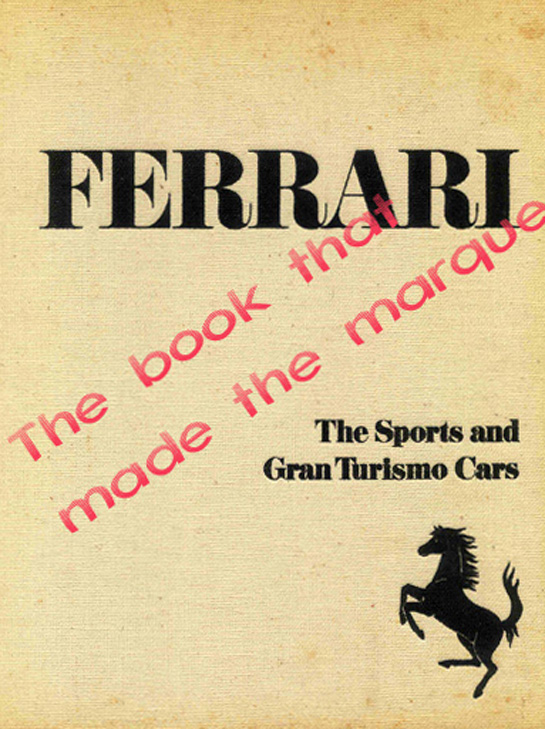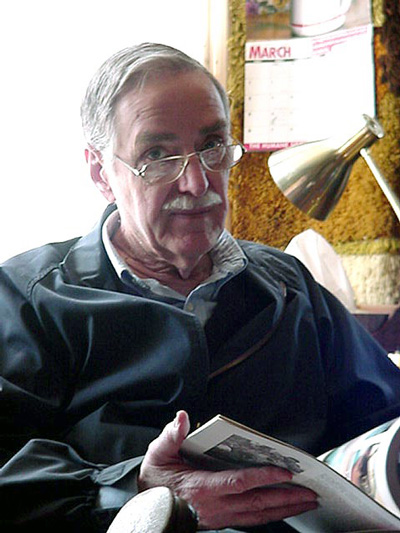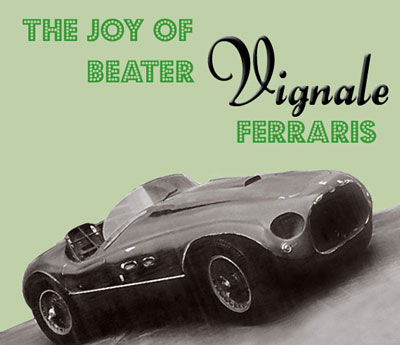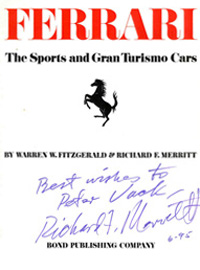Orginally published in 2007
By Pete Vack
Ferrari Historians expound on the first comprehensive book about Ferrari
By the mid 1960s, many used Ferraris were falling apart, found in cheap suburban tract housing behind chainlink fences, the Vignale or Ghia bodywork hidden by tarps, dogwatched by a mut on a rope. Most were in America; Illinois, California, New York, Long Island, Boston, and military ports like Long Beach, Norfolk, Jacksonville, San Diego, although old Ferraris could and would be found in Europe, South America, and Australia.
They were usually in the hands of well-meaning, somewhat knowledgeable foreign car enthusiasts who knew what they had but did not have the time, energy or money to properly restore their treasure. Many were young, but saddled with family responsibilities that precluded investing any grand sum into fixing a car whose value was at the very best purely speculative.
Once such young man was Richard F. Merritt, who had worked at Ford, GM and selling Volkswagens part time, and who realized that the Ferrari would be the next Bugatti. Over the years, Merritt would buy and sell 48 of the most desirable Ferraris ever built, but his main claim to fame would come as the co-author (with Warren Fitzgerald) of the landmark “Ferrari, the Sports and Grand Turismo Cars”. If any one book made the marque, it was this one, hereafter to be referred to as “F&M” for Fitzgerald and Merritt.
The post war classic car market boom was just emerging. Bugattis were among the most sought after, with prices ranging from $4000 for a Type 43 to $10,000 for restored Type 35s. A 1932 Alfa Romeo 2.3 with a Graber body was advertised for $14,000, and this was a high end classic. There were many cases of Ferraris without engines or with American V8s which turned hands for a few hundred dollars. We kick ourselves over these stories and anecdotes, but in reality, Ferraris for the most part, were not cheap in terms of 1968 dollars. Good used Ferraris were expensive. Ed Niles offered a 1964 Superamerica for $9,500; a 1964 Lusso went for $7195, while a 250GT SWB was offered at $6300, totally restored. Bugatti had nothing on Ferrari insofar as prices were concerned.
For comparisons, a quick look at the new car market found that a 330GTS was priced at just around $15,000, a Fiat 124 Spider, $3226, and a Fiat 850 Spider at just $2100. More expensive than a new Ferrari was the outrageous Lamborghini Miura, with a sticker price of a whopping $21,000.
Young Merritt’s goal was to save the early, classic Ferraris from the junkyard, not to increase the value, although it was a given that prices would eventually rise (no one, not even Dick Merritt in his wildest dreams could have imagined just how far prices would eventually rise). Merritt knew that as long as people did not know the history of the car or had no means of finding out, the Ferraris would remain behind chain link fences, including his own.
Taking a cue from the Bugatti Owner’s Club, Merritt realized that for a car to become desirable and collectable, three things were needed: a club, a collector, and a book. In 1963, Merritt had participated in the creation of the Ferrari Club of America, and by 1965 had persuaded Carl Bross into collecting old Ferraris. Now they needed a ‘bible’, a book to be used for identification of the myriad of Ferraris built from 1947 on. On a trip to California to search for Ferraris, Merritt met John and Elaine Bond, publishers of Road & Track, and convinced them to publish a comprehensive book on Ferraris. Merritt pulled in Warren Fitzgerald, who was writing classic car articles for Road & Track. With Merritt’s expertise, Fitzgerald’s writing abilities and photos from the R&T archives (among others), the book became possible. The decision was made, and suddenly the new authors found themselves with only a year to write the book. “If you notice there are 12 chapters in the F&M book,” said Ferrari expert and owner David Seielstad. “Dick and Warren wrote a chapter a month meeting the deadline.”
In an interview with Jackie Jouret in the April 2001 issue of Forza magazine, Merritt recalled that he “had to ‘talk his head off” to get Bond to publish.. And even though the book was enormously successful, the Bond R&T book publishing venture did not succeed. According to Merritt, Dean Batchelor, who headed the new book division, “was fired because it was losing money” despite the F&M book, which went on to four editions. Batchelor founded his own publishing company and produced two books on Ferraris in the mid 1970s.
In the summer of 1968, there was not many books to choose from if Ferrari was your heart’s desire. One was Hans Tanner’s 1959 book on Ferrari, an excellent and useful book but one which primarily addressed the formula and sports race cars and had few photos. The only other book in print at the time was “Ferrari Pininfarina”, a book compiled from Style Auto by Girogio Bella and Mario Dinarich which featured 180 photos of Ferraris by that coachbuilder. And then, apparently no longer in print, was Ferrari’s biography, published in English as “The Enzo Ferrari Story” by MacMillan press in 1962.
The field of books on individual cars was wide open but risky. Autobooks, an major bookseller in Burbank, advertised in R&T but had very few books listed. Bentley Publishing in Cambridge, Massachusetts, listed only 29 titles in 1968. Classic Motorbooks, a new company in Minneapolis which would both sell and publish automotive books, featured a one page ad and listed 103 titles, but of these only 66 were actually hard cover books–the remainder were drawings and magazines. Among the marque titles, five were on Alfa Romeo, but none on any other Italian car.
The most expensive book one could purchase was Setright’s new 440 page “Grand Prix Car, 1954-1966” at $22.50, a major work. The vast majority of automotive titles were priced between $5 and $10, and Bentley offered a “buy one for $1 if you buy another at the regular price.” With a cloth cover encased in a plastic sheath, F&M had 12 color photos, 300 B&W, but was thin at only 216 pages. The price was also a landmark. Pre pub price was $17.50 but the regular price was $20.00. And that, in 1968, was more than twice as much as the average hard back automotive book.
So what kind of a book did you get for your $20? It was arranged not in chronological order, but by development, and in those twelve chapters F&M laid out the Colombo and Lampredi engines, the chassis variations, the early coach built cars, the production cars, and the sports race and GT cars. It was clear, concise, practical and identified many of those gorgeous, strange, and exotic Ghias, Vignales, Touring bodied cars.
In that winter of 1968, David Seielstad received his copy. “I loved the book. Reread it and reread it, identified serial numbers on as many photos as possible, underlined passages, corrected text in the margin. It was well organized and full of photos. The book had a huge impact. Ferrari ads started including the ‘see pg. NN F&M upper right.’ From that point on, everyone selling or buying a Ferrari just referenced it.” At the same time, Alan Boe, today a contributor to Cavallino, Ferrari owner and concours judge, received his copy of F&M. “When I got my copy I was very impressed, especially with the technical and historic content, and especially with all the b & w photos, plus the color fold-outs.” Author and historian Michael Lynch recalls what he thought when he received his first edition. “I thought it was fantastic. For the first time, I was able to understand Ferrari as a concept, rather than a bewildering array of seemingly unconnected models.”
For all of that, the book lacked an essential means of identification. The use of chassis numbers to track classic cars was not yet in vogue, but it was something that Merritt was working on. F&M did not provide any chassis number information. Guys like Seielstad penciled in the numbers next to the photos and soon a large, if inaccessible, data bank of information came into being. Merritt had started a log book of chassis numbers consisting of about the first 1500 Ferraris (“I went up to 1500, figuring that’s the end of the really great cars,“ said Merritt.) There were a lot of blanks, and in 1969–after the publication of the book, he went to the Ferrari factory with his log of Ferraris, and requested that the factory put the correct serial number by each car. To his amazement they did, though he had to leave the log in Italy for a few weeks.
Equally amazing is that F&M has weathered so well over the years, despite the work of hundreds or perhaps thousands of owners, historians, authors, and restorers who have delved deeper into Ferrari history. “I have reread my first edition recently and it holds up very well. F&M did their homework and got most of it right. It has a dynamite index, handy even today as a spell checker.” said Seielstad. “ It was a great book when first published and remains so today. There have been a lot of Ferrari titles, (probably over 800), but many are full of errors or thin on copy with nice photos. F&M remains the best Ferrari book, if you can only have one Ferrari title in your library, then you must have F&M.”
Alan Boe agreed. “I guess it was expensive at the time, but for me it was essential to have a copy. I’d have paid twice as much so, of course, it was worth it. I still use it today for research as it has proved to be an invaluable tool and has stood the test of time. F&M was far ahead of all of them when it comes to content, layout, photos used, and accuracy. Easily one of the best Ferrari books EVER published — it still is invaluable.” Lynch touched on another point. “It was the seminal book on Ferrari and will always remain so. I also find it interesting that two Americans did what several Italians should have done.”
The book did well, but it did not appreciate nearly as well as the Ferraris Merritt was buying and selling. Copies of F&M can be found for as little as $20 and as much as $300 depending on edition and condition. Merritt ads that “The late Jonathan Thompson was the in-house editor at R&T and he did the later editions which added chapters on the end to bring it more up to date with later developments, so he deserves a lot of credit.”
Today, Dick Merritt still works at the DOT, where he has been since 1983. When asked for his thoughts on the landmark book he co-authored, he said “I think it is highly important that NO publisher could be persuaded that there was a real market for a Ferrari book until they saw what a success F&M was. So we opened the door in reality to authors who wanted to do their book on certain models or body builders. Thanks to F&M we now have dozens, even hundreds of books by authors who have greatly expanded our knowledge of the marque. That makes me most proud and thankful.”




Merritt’s forgotten more than any of use will know. I wish that Fitz had lived to see the state of affaires today.
What? A Chuck Queener designed/John Lamm written book for $15?! What is the world coming to? My copy is winging it’s way to me at this moment.
How are you Chuck? It’s been a long time, and over the course of that time passage, I’ve finally joined the club and found out what all the fuss was about. I look forward to getting the book.
Cheers,
Bob Weber
Pete, many, many thanks for this article on Dick Merritt. I am delighted to say that Dick is a friend and a man whom I respect tremendously. I bought a copy of his book too, in the spring of 1969, from R&T. I got the rare edition, without the plastic cover..I later bought each of the updated editions and now have four in all, and three of them are personally autographed to me by Dick. Dick, you inspire all of us vintage Ferrari gearheads.. Fantastic!!
Regards
Clem.
I received the book as a gift many years ago. I finally ceded it to my son who each time he came to visit would sit transfixed. A great book and an even greater story.
I have that first edition. At that time there were not many books about European cars being published. Even though I was not a big Ferrari fan, it was from Bond Publishing and that was enough. I have a small collection but I could never have kept up with the deluge of books that came out soon after that.
I agree that the publication of the Fitzgerald-Merritt book made Ferrari’s wide range
of models comprehensible to Americans who had only fragmentary reference material before. I notice that in other marques, the values of the cars was “stalled” because there was so little information but now that there are comprehensive books on the cars of Iso, Bizzarrini and Intermeccanica, it becomes possible to see where a particular car you lust after fits in the whole picture. The more thoroughgoing of the books also unmasks fake cars that could exist as
long as there was no comphrehensive book. It’s too bad, though, in Italian marques other than Ferrari, there are no serial number experts as well versed as those who thrive in the Ferrari field (such as Marcel Massini) , with a consequent lack of faith that the car you are looking at is the car it may be represented as. Still, the publication of books on each marque gives the marque a historical leg to stand on.
I loved my copy of this book and purchased the subsequent editions as they were issued. The Ferrari Owners Club arranged for a visit to the Road & Track offices where we all acquired our copies and reveled in the photos and text. My favorite photo in the book–one that I would spend long moments fascinating over–was of Ulf Norinder’s re-bodied GTO. The book was a touchstone for all of us who cared about Ferraris.
Dick and Warren ignited a fire that still burns in our collective hearts. Their template has also been copied countless times for marque books of considerably less real value. While I have built and sold two good sized Ferrari libraries, the current—and last—collection covers much of the detail history, but when I reach for a Ferrari book for reliable historical perspective it is usually my copy of Fitzgerald, Merritt & Thompson. Thanks Dick.
Even today I still regard Warren and Dick as best friends. Enthusiasts should remember that the FCA established the Warren Fitzgerald Memorial Award in ’74 for the best writing of Ferrari history over the past few years as the book was so inspirational and deserved recognition. The award was a polished bronze cast prancing horse on a marble base. Over the years it has been forgotten but this year has been revived as a very prestigious item. The first one was presented to Enzo Ferrari who placed it on the top shelf of his bookcase at his office at the Pista de Fiorano. Dave Cummins
I first met Warren in mid 1963 after Graduating ACS in LA and joining GM Styling
at the Tech Center in Warren, MI. One of my fellow designers and I had modified a Panhard that used to park in front of our studio in plain view with a huge pink tongue out of the grill and a couple of flirty eyes on the headlights! Warren happened to make one of his regular visits, saw the Panhard, cracked up, and immediately called the staff photographer to take a photo of it! He thought it was great!! We became good friends after that and he came in on several occasions and asked me if I wanted to go for a ride. I then found out he did vintage auto articles and reviews for R&T. He took me on several rides around the Tech Center, including, I believe, a ’34 or ’35 V16 Cadillac! My favorite, however, was a 3.8
Jaguar SS 100! He really hammered it through the turns and straights jn front of the Fountains and a complete tour of the GM Tech grounds! What an experience!!
I left GM a year or so later and joined Ford Design in Dearborn but kept in touch with Warren! I still have the Ferrari book signed by Warren and Richard that Warren gave me when it came out!! A very cherished item!!!
Great man! He was, and still is, missed by us Car Guys!!!